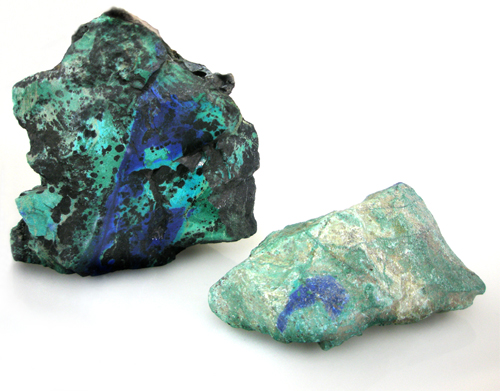 |
|
Azurite Malachite Azurite – malachite is of course the combination of both azurite and malachite which crystallizes normally in the form of masses, crusts, and nodules. When Azurite mixes with green malachite, a lovely swirl of blue and green colors occurs. It is also found in China, but it's found almost anywhere you have copper present. The best specimens come from the USA. Azurite is a soft, deep blue copper mineral produced by weathering of copper ore deposits. The blue of azurite is exceptionally deep and clear. Specimens tend to lighten in color over time due to weathering of the specimen surface into malachite; this is why they are found together. Malachite is a green-colored mineral which crystallizes in the monoclinic crystal system, and most often forms botryoidal, fibrous, or stalagmitic masses. Individual crystals are rare but do occur as slender to acicular prisms. Pseudomorphs after more tabular or blocky azurite crystals also occur. Malachite often results from weathering of copper ores and is often found together with azurite. Except for its vibrant green color, the properties of malachite are similar to those of azurite and aggregates of the two minerals occur frequently together. Malachite is more common than azurite and is typically associated with copper deposits around limestone. Large quantities of malachite have been mined in the Urals. It is found in Africa, Russia; Mexico; England, France in the Southwestern United States. In Israel, malachite is extensively mined at Timna valley, often called King Solomon's Mines. Archeological evidence indicates that the mineral has been mined and smelted at the site for over 3,000 years. Azurite was used as a blue pigment for centuries. Older examples of azurite pigment may show a more greenish tint due to weathering into malachite. Much azurite was mislabeled lapis lazuli, a term applied to many blue pigments. Malachite was used as a mineral pigment in green paints from antiquity until about 1800. The pigment is moderately lightfast, very sensitive to acids and varying in color. Azurite and malachite are used occasionally as beads and as jewelry, and also as an ornamental stone. The intense color of azurite makes it popular collector's stone. However, bright light, heat, and open air all tend to reduce the intensity of its color over time. To help preserve the deep blue color of a pristine azurite specimen, collectors should use a cool, dark, sealed storage environment similar to that of its original natural setting. Azurite-malachite generally allows one to reach into the inner depths without fear, so that one is sustained, absolved and is aware of the genesis of all time. Azurite-malachite bestows upon one the cleansing of the immutable forces and refreshes ones outlook to be as the wind in the willow. It produces a flow to actions and willingness toward flexibility. |
Desert Rosing Trading. All Rights Reserved.

